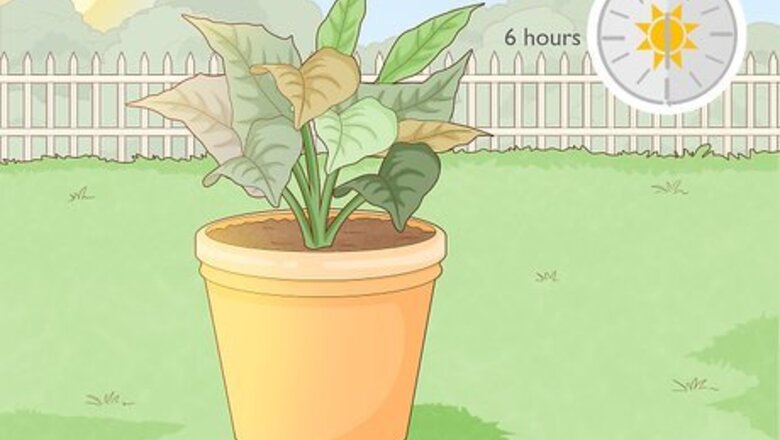
views
Saving Your Poinsettia After the Winter
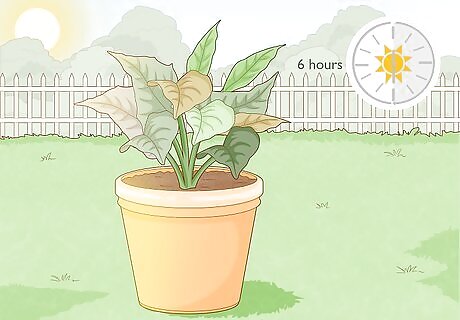
Place your poinsettia where it can get at least 6 hours of sunlight a day. As soon as you’ve made the decision to rescue your leftover poinsettia, relocate it to a well-lit spot inside your home. Settings with bright, filtered sunlight, like an east or west-facing window or an open living room, will offer the best results. Poinsettias are light-loving plants that need lots of indirect exposure to remain viable.
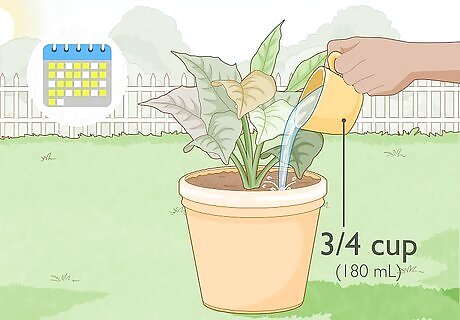
Water your plant thoroughly every few days. The exact amount of water you use will depend on the needs of the plant, the size of its container, and the temperature of its surrounding environment. As a general rule, however, you should pour in just enough to moisten the soil. Repeat as frequently as needed, allowing the soil to dry to the touch between waterings. Most average-sized plants will need about ¾ cup (180 mL) of water every 1-2 days. Be careful not to overwater your poinsettia. Soggy soil can lead to root rot and other complications that can easily kill the plant. Make sure that the pot has holes on the bottom for drainage. If it doesn't, get a different pot or drill holes into the bottom.
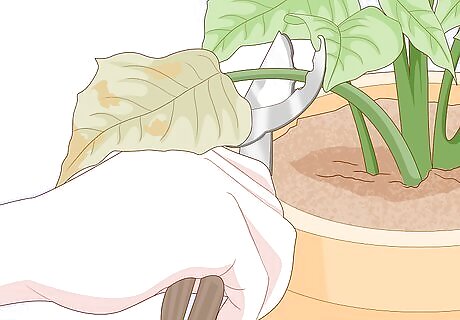
Prune dead foliage. Scan the poinsettia for old leaves that have shriveled up or lost their color and pluck them away by hand. Be sure to remove any leaves that have already fallen into the plant’s container, as well. Healthy-looking foliage can be left intact. Your poinsettia may look like little more than a bare stick by the time you’re finished pruning. This is completely normal. The colorful foliage will return once the plant emerges from dormancy in the spring.
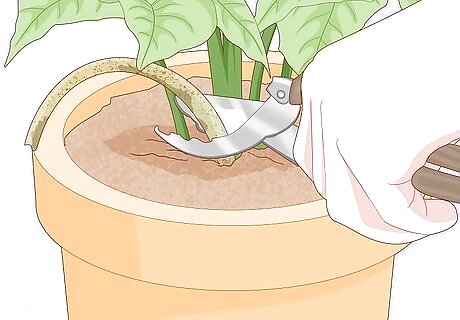
Cut back stems that have begun to rot. Inspect the plant for mature stems that appear sickly or discolored. Use a pair of pruning shears to clip these at least half an inch below the affected area. It’s possible that you may end up clipping all of the existing stems, leaving only the newer offshoots at the base of the plant. Trimming the stems will also help stimulate new growth in plants that are still healthy. Add rotten stems and foliage to your compost pile to convert it into organic material that you can use to treat your poinsettia once it starts growing again. If the stems are diseased or carry pests, however, throw them away in the garbage and not the compost pile.
Encouraging New Growth in Spring and Summer
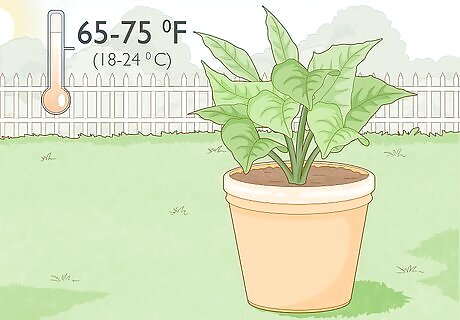
Keep your poinsettia at a constant 65–75 °F (18–24 °C). Poinsettias are most comfortable at about the same temperature you are. Fortunately, this means that they’ll be content in almost any room of the house. Situate your plant away from any doors or windows that you open frequently. Poinsettias don’t hold up well under a draft. Do not place poinsettias near heaters, radiators, or vents. Avoid raising or lowering the thermostat too dramatically when temperatures outside fluctuate.
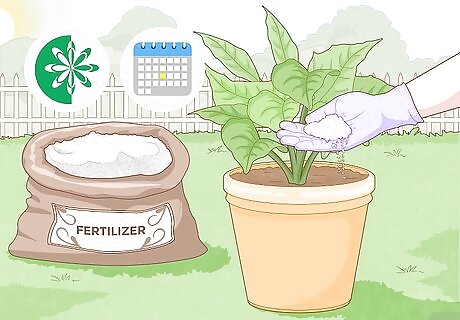
Fertilize your poinsettia once a month throughout the spring. Fertilizers are essential for adding vital nutrients to your growing soil. Balanced water-soluble houseplant fertilizers are the safest choice for delicate plants like poinsettias. Always use the amount specified in the instructions of a particular product. You can also use a natural organic material like garden compost or worm castings to fertilize your poinsettia. The best time to apply fertilizer is soon after watering, while the soil is still moist. Fertilizing poinsettias in dry soil could damage the roots. Plan on reapplying fertilizer about once a month while the plant is in its most active stages of growth.
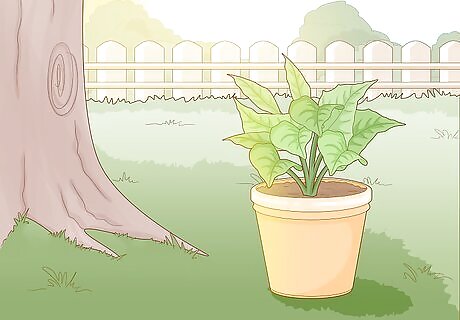
Move the plant outside to a spot with indirect sunlight. Let your poinsettia sit outdoors for a few hours on warm afternoons. Place the plant in a partially-shaded area so it doesn’t overheat. Screened-in patios and flower beds protected by tree cover can make great outdoor homes for growing poinsettias. Introduce your poinsettia to outdoor conditions gradually. It’s usually best to start with a few hours in the early morning, then increase its exposure by an hour or two every day until it’s able to withstand an entire afternoon. Look for a spot in your garden with plenty of morning sun but more shade in the afternoon. It may be necessary to water your poinsettia more frequently if it’s been spending a lot of time in the hot sun. Drooping, wilting, or wrinkled leaves may be a sign that your plant has been outside too long.
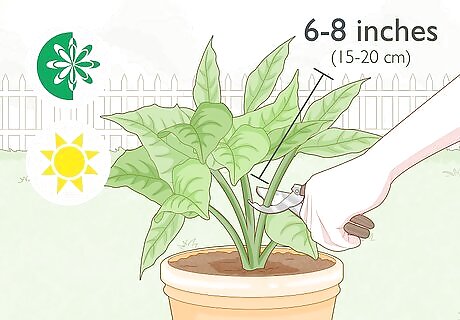
Trim the stems back to 6–8 inches (15–20 cm) in the spring or summer. Once the weather begins to heat up, it can be helpful to cut away roughly a third (or even up to half) of your poinsettia’s overall size. Strategic pruning is necessary to kickstart growth. It will create a bushier, fuller plant. By removing the stems, you’ll be redirecting more of the plant’s resources into producing new flowers and foliage. If you’d prefer to hold off on doing the bulk of your pruning, you can wait until around midsummer when the poinsettia has reached its full size.
Getting Your Poinsettia to Rebloom
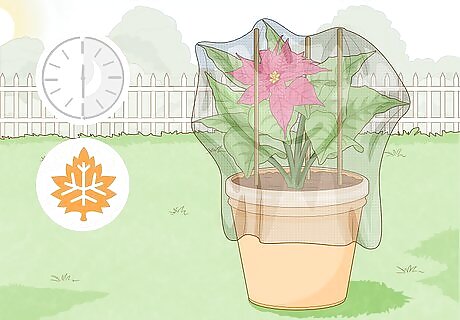
Cover the plant overnight during the fall to promote flowering. In order to produce vibrantly colored bracts (or leaves) after a dormant period, your poinsettia will need to spend 12-14 hours a night in total darkness between September and November. Place a black fabric bag or cardboard box over the plant every evening at sundown. Uncover it again the following morning when it's time to meet its sunlight requirements. Consider tucking your poinsettia away in a closet or basement after covering it. Even the faintest ambient light can be enough to prevent it from blooming on time. Poinsettias are photoperiod plants, which means the amount of foliage they produce is determined by the number of hours a day they spend without light.
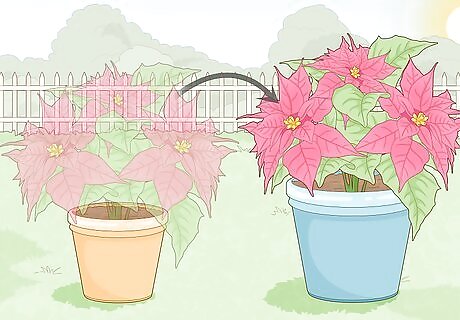
Repot your poinsettia in a larger container. Eventually, your rejuvenated poinsettia may get so big that it outgrows its original pot. When the new growth begins to stall, transfer the plant to a new container where its root system will have plenty of room to continue expanding. Take care not to damage the delicate roots themselves when extracting the plant. Any well-balanced potting soil mix should work just fine for filling the new container. Continue watering and fertilizing your poinsettia as usual once you’ve transplanted it successfully.
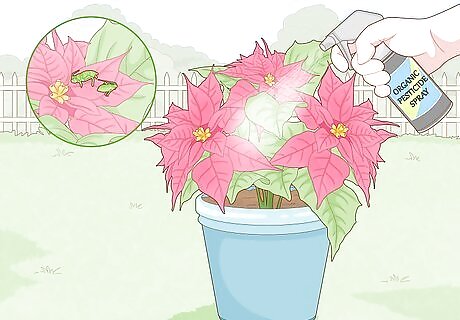
Use pesticides to ward off unwanted insects. Common garden pests like aphids and whiteflies have been known to feed on poinsettia leaves. The best way to minimize the damage they do is to spray the plant periodically with a mild organic pesticide, such as neem oil or insecticidal soap. If there are only a few invaders present, you may be able to simply remove them by hand. Keep in mind that organic pesticides typically have to be reapplied more frequently than chemical products due to their gentler ingredients. If you don’t like the idea of treating your plant with pesticides, try mixing up your own homemade solution by combining an all-natural liquid soap with warm water in a spray bottle and using it to blast bugs whenever they pop up.
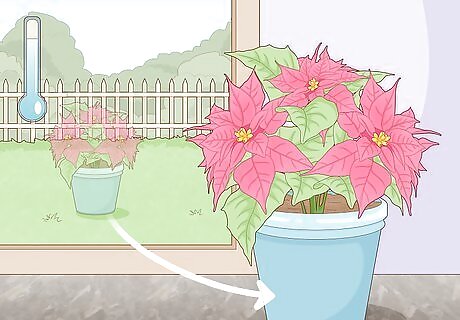
Bring your poinsettia back indoors when temperatures begin to drop. By mid-fall, it will be too chilly to keep your poinsettia out during the day. Find a warm, cozy spot for the plant inside your home where it can enjoy 6-8 hours of indirect sun exposure per day. If it has made it this far, chances are it will have no trouble thriving for another season. It may be alright to leave your poinsettia outdoors throughout the fall and winter if you live in a region with a particularly warm climate. The temperature should be above 50 °F (10 °C) at all times. The important thing is to protect it from frost and prolonged exposure to freezing temperatures.
















Comments
0 comment